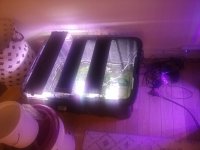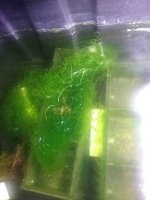- Location
- Queens, NY
6 weeks ago, You see these guys for sale everywhere. Picked up an active naso tang at 3.0 -3.5" for $35 and a small clown tang for $30. To keep them company there are also a few damsels in there. Had it in Hyposalinity while in quarantine, water conditions are perfect, weekly water changes, change out the carbon every 2 weeks, running on 2 separate small internal cascade filters, have plenty of algae growing in my main setup so I feed it to them.
Everything started well. The naso started eating the fine algae from day one and the clown nibbled on it for the first week, then the clown seemed to stopped eating and get thinner and thinner till at 2 weeks it died. At this point the naso also became less active, but is looking pretty well fed, since the ulva I was feeding it seemed to have taken hold and is continuously growing in there now. I didn't need to add anymore. He never adapted to dried nori and I can see it grazing, so I stopped adding.
Fast fowards to week 6. So I've finished up the hyposalinity treatment and started bringing the salinity up from 1.010 to 1.014 this past weekend. Then I noticed the naso has been lethargic this past week. I didn't think much of it at the time. I moved my hand in there and he was so weak, I could pick him up. He is definitely very weak, but has plenty of muscle mass and a full belly. I thought since the clown died, he just didn't have too much reason to swim around anymore, but something else is up. The damsels are doing well.
My first thought, is drop in oxygen concentration caused by something, (perhaps too much algae is growing now and the levels drop every night), so I added a giant air stone today, but there is already plenty of water movement. I clean out the cascade filters every week and it's not clogging up. I know that as salinity increases dissolved oxygen drops. So if this is the reason, that will fix it. Tangs need lots of oxygen.
Second though, the flat worms that I have growing in my algae scubber must be exploding in the hypo salinity when I added that last big batch of seaweed and it's toxicity has accumulated and I should have done carbon changes every week instead of 2. (/curses!) If this was so, the 25% water changes I've been doing this past 3 days to bring up the salinity should have fixed this also. (Timing is about right, I haven't added ulva since then). but the damsels, my canary in a coal mine, are doing well. Anyway, I'm going to add in more carbon now, scatter it around the tub, not just replace the 2 tablespoons worth inside the internal filters, as this is also a possibility.
Third and final though, Are they still fishing using cyanide and selling fish cheap? This link is from 2008, I don't know if anything has changed in the past decade.
There is really no other reason why this naso is dying and the damsels are not. The clown I gave up on, it wasn't going to make it if it didn't eat enough, but with hind sight... these fish are from south east Asia, right?

 www.wri.org
www.wri.org
NOTE: originally had 2 light fixtures on it, but since both fish ate up all the algae at week 2, I added a third, which has caused the last batch of ulva to take hold.
Second pic is of the ulva itself, and some plastic pipes/boxes to separate the fish somewhat, give them more "area" to swim around in. This keeps the fast moving water separate from the ulva side.
Everything started well. The naso started eating the fine algae from day one and the clown nibbled on it for the first week, then the clown seemed to stopped eating and get thinner and thinner till at 2 weeks it died. At this point the naso also became less active, but is looking pretty well fed, since the ulva I was feeding it seemed to have taken hold and is continuously growing in there now. I didn't need to add anymore. He never adapted to dried nori and I can see it grazing, so I stopped adding.
Fast fowards to week 6. So I've finished up the hyposalinity treatment and started bringing the salinity up from 1.010 to 1.014 this past weekend. Then I noticed the naso has been lethargic this past week. I didn't think much of it at the time. I moved my hand in there and he was so weak, I could pick him up. He is definitely very weak, but has plenty of muscle mass and a full belly. I thought since the clown died, he just didn't have too much reason to swim around anymore, but something else is up. The damsels are doing well.
My first thought, is drop in oxygen concentration caused by something, (perhaps too much algae is growing now and the levels drop every night), so I added a giant air stone today, but there is already plenty of water movement. I clean out the cascade filters every week and it's not clogging up. I know that as salinity increases dissolved oxygen drops. So if this is the reason, that will fix it. Tangs need lots of oxygen.
Second though, the flat worms that I have growing in my algae scubber must be exploding in the hypo salinity when I added that last big batch of seaweed and it's toxicity has accumulated and I should have done carbon changes every week instead of 2. (/curses!) If this was so, the 25% water changes I've been doing this past 3 days to bring up the salinity should have fixed this also. (Timing is about right, I haven't added ulva since then). but the damsels, my canary in a coal mine, are doing well. Anyway, I'm going to add in more carbon now, scatter it around the tub, not just replace the 2 tablespoons worth inside the internal filters, as this is also a possibility.
Third and final though, Are they still fishing using cyanide and selling fish cheap? This link is from 2008, I don't know if anything has changed in the past decade.
There is really no other reason why this naso is dying and the damsels are not. The clown I gave up on, it wasn't going to make it if it didn't eat enough, but with hind sight... these fish are from south east Asia, right?

Destructive Fishing is Widespread in Southeast Asia
The use of cyanide to stun and capture live coral reef fish began in the 1960s in the Philippines to supply the growing market for aquarium fish in Europe and North America, a market now worth more th
NOTE: originally had 2 light fixtures on it, but since both fish ate up all the algae at week 2, I added a third, which has caused the last batch of ulva to take hold.
Second pic is of the ulva itself, and some plastic pipes/boxes to separate the fish somewhat, give them more "area" to swim around in. This keeps the fast moving water separate from the ulva side.
Attachments
Last edited:







